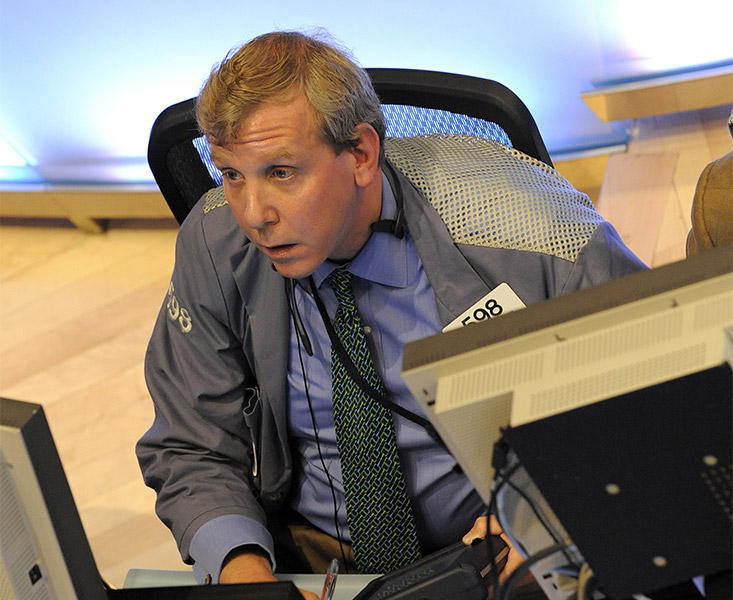At about 2:30pm on May 6, 2010, an asset management firm began executing a series of orders on the Chicago Mercantile Exchange. Located in Overland Park, Kansas, Waddell & Reed was (and is) one of the oldest mutual fund companies in America. It followed a strategy based on fundamental analysis—Wall Street code for old-fashioned investing. That afternoon, it wanted to sell 75,000 futures contracts on the S&P 500, a major market index, before the market closed at 4 p.m. The order was large but basically unremarkable, and Waddell & Reed had been executing similar trades for decades.
But this time something was different. Within 20 minutes of Waddell & Reed’s initial order, S&P 500 futures had declined 5 percent, and individual equity prices began to oscillate wildly. The price of the consulting firm Accenture declined from roughly $30 to $0.01 in seven seconds. Consumer goods giant Procter and Gamble dropped from around $60 to $39. Shares of Apple tumbled 20 percent from their pre-crash price of approximately $250, and also traded at nearly $100,000 per share (trades which were later annulled by the exchange). The dramatic futures move and the massive and sudden dislocation in the equities markets on that day came to be known as the Flash Crash.
How did the Flash Crash happen? The Securities and Exchange Commission (SEC) and the Commodity Futures Trading Commission (CFTC) arrived at one explanation in their official joint report, published in September of 2010. According to the report, many of the firms that bought the initial batch of futures from Waddell & Reed used automated trading software. Each purchase introduced additional market exposure and risk, prompting these trading programs to hedge their own risk by selling these same futures. Other automated traders took the other side of these trades, then also sought to offload their risk in the market. Each trade that Waddell & Reed made therefore caused multiple trades in response. In addition, Waddell & Reed had instructed their own trading program to trade no more than 9 percent of the total volume of the futures contracts traded at any given time, so that their algorithm didn’t trade too aggressively. But the algorithm wasn’t given any restrictions on price, or the time it should take to finish its order. It began to ramp up its own volumes exponentially in response to the activity that it itself had initiated, all the while maintaining its 9 percent volume cap. As the firms buying from Waddell & Reed accumulated risk, they began to require more incentive to continue buying futures. Prices began to fall. And since the different firms that were trading with Waddell & Reed’s orders also were generally using similar algorithms, their behavior became strongly correlated, pushing the markets in the same direction: down.

But then, almost as quickly as it had started, the crisis resolved itself. During the next few minutes, following an automatically triggered pause in futures trading, firms began to see the depressed market as a buying opportunity. Trading systems were reactivated and liquidity was restored. The market recovered to almost to its pre-crash level.
Some commentators remain skeptical of the SEC-CFTC’s official explanation. For example, the Chicago Mercantile Exchange, where the trades were executed, argued that a trade of the sort that Waddell & Reed had executed was too small, or too common, to explain such an extreme and unusual event. Firms like Waddell & Reed may make dozens, even hundreds, of similar trades without a hitch every year. Then just this past Tuesday, on April 21, a United Kingdom-based futures trader called Navinder Singh Sarao was arrested on wire fraud and market manipulation charges. He stands accused of placing large sell orders in S&P 500 futures without ever intending to have those orders fulfilled. Instead, regulators and prosecutors allege, his orders were intended to trick the market by increasing sell pressure on the futures. Regulators allege that the trick worked, making Sarao millions of dollars in profit. Furthermore, regulators have taken pains to emphasize that he employed this strategy on the day of the Flash Crash. His activity caused a sudden loss of liquidity and “directly contributed to the … price crash,” according to the CFTC’s complaint.
Like a nuclear power plant, modern markets are both interactively complex and tightly coupled.
So which explanation captures the dynamics that led to the crash? Could an ordinary order in the futures market or a lone market manipulator really cause the crash? The simple answer is that this is the wrong question to ask. From the perspective of the joint report and the enforcement action, the Flash Crash was a fluke, an idiosyncratic event caused by an unexpected glitch in the markets. But it was far from being a fluke. Instead, the Flash Crash reveals that we need a fundamentally different understanding of how modern financial markets work. We believe that it shows us that markets are governed by the same principle as earthquakes and avalanches: self-organized criticality.
A critical phenomenon is one in which changes in one part of a system reverberate throughout the rest of the system, allowing a small perturbation to trigger an extreme effect. In many systems, critical phenomena only occur under special circumstances, within a narrow range of parameters. In other cases, though, a system can exhibit “self-organized criticality.” This means the system can spontaneously depart from mild and predictable behavior and evolve to a state where critical phenomena begin to occur. It combines long stretches of predictability with bursts of radically different, unpredictable behavior caused by prosaic triggers—much like the market.
One well-studied example is the sandpile. Imagine sitting on the beach, slowly dropping grains of sand onto a pile. A given grain will land somewhere near the top of the pile and stay there. Gradually these grains will form a cone shape. The mathematics of how this sort of cone grows are well understood, and we can develop models that very accurately capture how sand piles grow. But sometimes something else happens, as Jordan Ellenberg describes in his Nautilus essay. A grain of sand will land on the pile, and then, instead of staying put, it will produce a chain reaction. It will hit a neighboring grain in just the right way to dislodge it; this second grain will hit another, again dislodging it; and so on, until there is a little avalanche. There is nothing special about the grain of sand that starts the collapse—it need not be bigger, or heavier, or fall in a different way from the hundreds of grains that just stay where they land. But it produces an outsized effect.
To see how small changes can reverberate through real-world systems, let’s turn to another disaster, the 1979 meltdown at the Three Mile Island nuclear power plant. Yale sociologist Charles Perrow has studied the interactions that cause complex systems to fail catastrophically. He categorizes these systems along two dimensions: interactive complexity and coupling. Systems with a high degree of interactive complexity are prone to unplanned and unexpected interactions that are difficult to comprehend in real time. If such systems are also tightly coupled, it is difficult to recover from a failure, because it propagates quickly. The dynamics of such failures often mimic the evolution of systems into critical states.
Flashes of wildness are every bit as much a part of market dynamics as long stretches of predictability.
What started as an isolated pump shutdown at Three Mile Island—a relatively prosaic trigger event—cascaded into a series of failures that interacted in unexpected ways, including a stuck valve in an automatic safety system and a misleading control room indicator. All of these failures occurred without the system being “tuned” to any specific state: They were self-organized. The inherent impossibility of directly observing the dynamics of a nuclear reactor made it difficult for operators to diagnose the situation. And the underlying, tightly coupled nature of nuclear power provided an opportunity for the trigger event to be amplified. All this led to outsized consequences: a partial core meltdown.
Didier Sornette at the Swiss Federal Institute of Technology has argued that market crashes are another example of self-organized criticality. Through Perrow’s framework, we see how the underlying structure of the market might lead to self-organized criticality. Like a nuclear power plant, modern markets are both interactively complex and tightly coupled. Their complexity comes, in part, from the layers of interacting technologies used by stock and futures exchanges, market data providers, and even the participants themselves, whose computers connect to exchanges to trade with proprietary and often closely-guarded algorithmic strategies. Likewise, markets are tightly coupled by the fact that market participants use models that rely on similar inputs and assumptions. Many firms also use the same class of safety checks to stop trading when things go wrong, which, as we saw with the Flash Crash, can amplify problems. The speed of trading in highly computerized markets also means that problems can evolve quickly, faster than operators can respond.
The analogy to sandpiles might also give us a hint about the origins of the Flash Crash. Just as any grain of sand can serve to start an avalanche, so could many factors have started the Flash Crash. In a self-organized critical system, the state of the system, rather than the precise characteristics of the trigger, is what matters the most.
Neither the Waddell & Reed sale, nor any single actor’s market manipulation, explain the Flash Crash. Indeed, if it were possible that the market could move 5 percent from a large order or the simple manipulations of one trader, we would expect such instances of extreme volatility to be much more frequent. Just as the sandpile can reach a state in which critical phenomena can occur organically, without any special preparation, so can the markets. This special sort of state happens rarely, which is why most of the time the market absorbs exactly the kinds of activities that have been cited as the cause of the crash. The important thing is that such states can happen, both in mathematical models of sandpile collapses and in real-world systems. And it is under these circumstances, when a system has evolved into a critical state on its own, that ordinary events can lead to something as extreme as the events of May 6, 2010.
This is why asking whether the Waddell & Reed sale, or the behavior of a manipulative trader, really caused the crash is a mistake. The disparate “causal” explanations of the crash can’t be reconciled with each other for a simple reason: They aren’t in conflict. The Flash Crash was an emergent phenomenon. Just as any grain of sand might cause the sandpile to collapse, and as Three Mile Island’s meltdown could be attributed to a failed pump, stuck valve, or operator error, the trigger for the Flash Crash could have been related to Sarao, Waddell & Reed, or something else entirely. The true roots were in the complexity of the system itself. The market was ripe for such an event.
In the years since the Flash Crash, the SEC has implemented measures to reduce tight coupling in the markets, and exchanges now pause trading if there are drastic price moves in individual securities. These measures help, but are they enough? The fundamental interactive complexity of the market and the unpredictable and difficult-to-observe interactions between software components, trading models, and market participants remain in place. Though we have avoided a repeat of the Flash Crash, similar events continue to occur. In May 2012, NASDAQ struggled to recover from a set of software glitches that delayed the Facebook IPO and resulted in hundreds of million dollars in alleged losses. The following August, Knight Capital, a major trading firm, dissolved after a software “glitch” caused them to lose almost $10 million dollars per minute for 45 minutes.
These flashes of wildness are every bit as much a part of market dynamics as long stretches of predictability. Focusing our attention on these long stretches of normal market behavior can be misleading, because they obscure the events that create the most important changes. Instead, we need to recognize that it is only by studying events like the Flash Crash that we can come to see how complex market forces interact with one another. The dominos are still there, self-organized by market dynamics that we do not fully understand and cannot directly observe or control. And we have no idea when they will topple next.
Chris Clearfield is a principal at System Logic, a boutique consulting firm focused on risk management in complex systems. James Owen Weatherall is an associate professor at the University of California, Irvine, and author of The Physics of Wall Street.






























